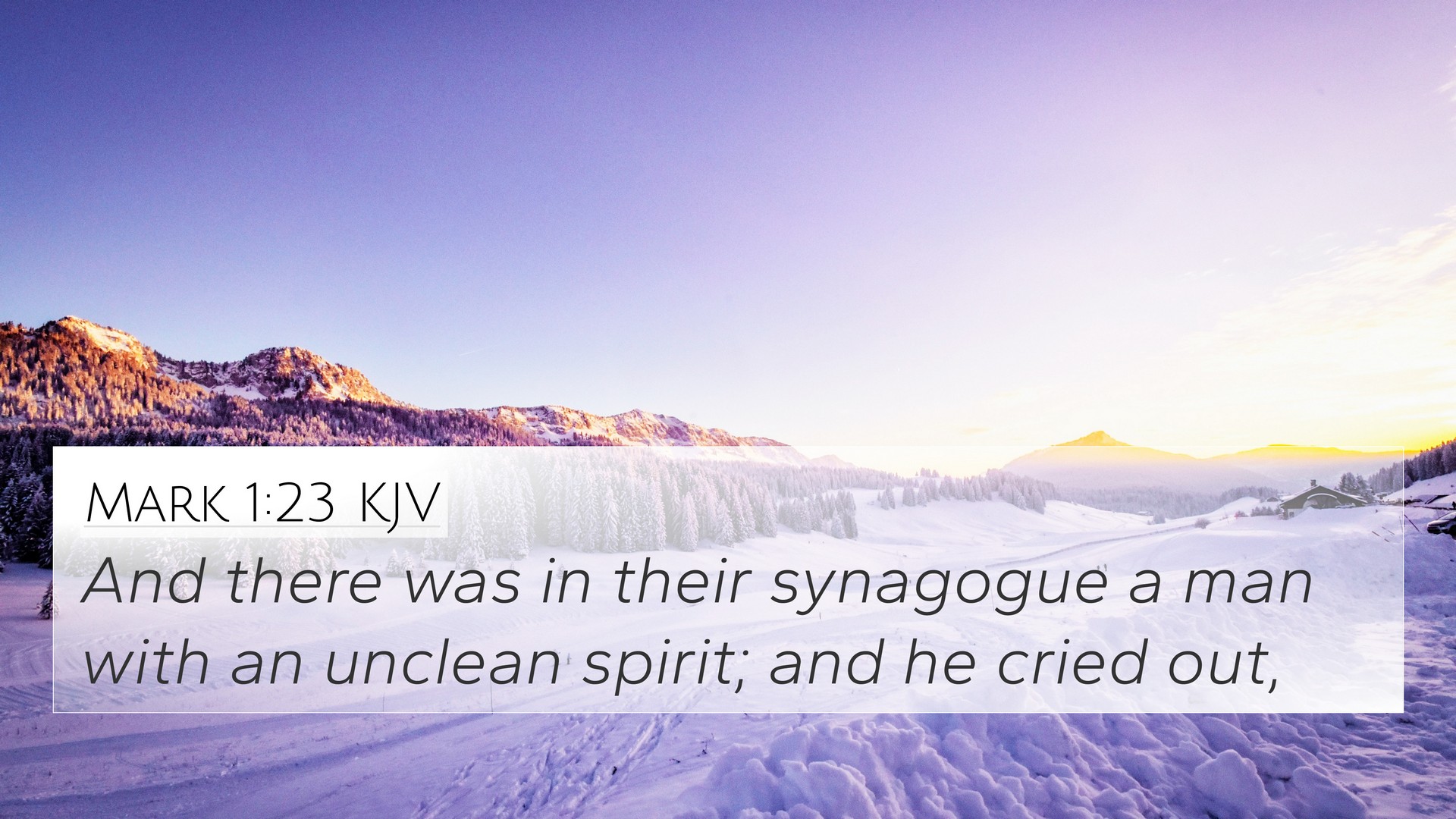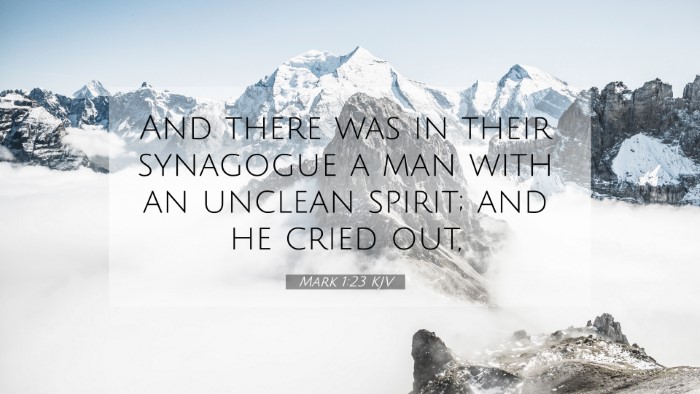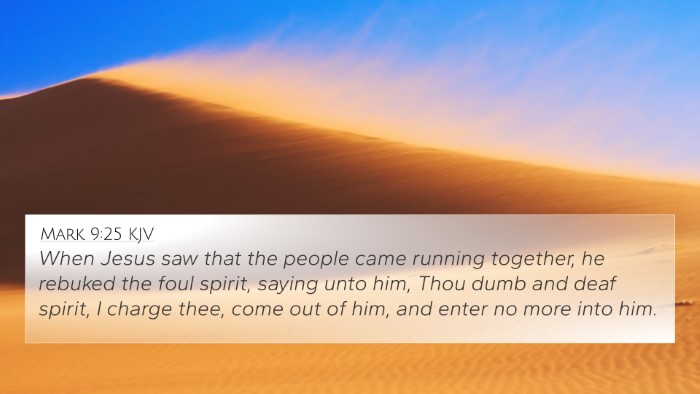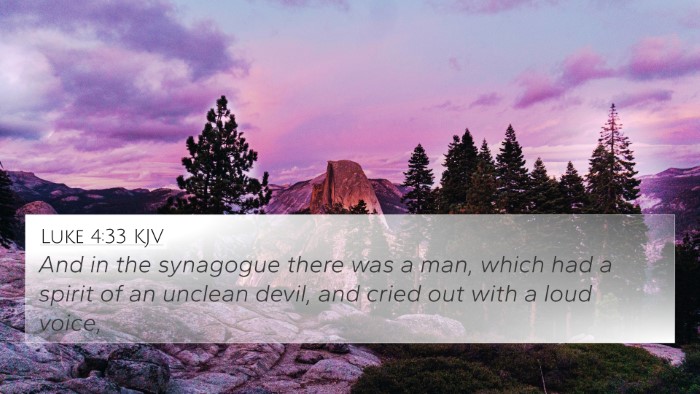Understanding Mark 1:23
In Mark 1:23, we find a profound narrative that unfolds during Jesus' early ministry. The verse states:
“And there was in their synagogue a man with an unclean spirit; and he cried out.”
Commentary Summary
This incident occurs in Capernaum, where Jesus is teaching in the synagogue. It is significant for several reasons:
1. The Setting: Synagogue Worship
The synagogue throughout Jewish history served as a place of worship and teaching. Matthew Henry notes that this was a common practice for Jesus, showcasing His dedication to both teaching and adherence to the Jewish customs of His day.
2. The Presence of Evil
Albert Barnes emphasizes the introduction of a man possessed by an unclean spirit, indicating that even within the sacred space of worship, evil can manifest. This demonstrates the constant spiritual battle faced by believers.
3. The Reaction of the Spirits
Adam Clarke explains that the cry of the unclean spirit reveals the recognition of Jesus’ authority. The evil spirit acknowledges Jesus not just as a teacher, but as the Holy One of God. This highlights the theme of Jesus' divine authority that runs throughout the Gospels.
4. Theological Implications
The presence of the unclean spirit opens discussions about oppositional forces in spiritual warfare. This directly connects to various theological discussions within the broader context of Scripture.
Cross-References and Related Verses
Mark 1:23 is deeply connected to a series of other Bible verses, showcasing the thematic and narrative links throughout Scripture:
- Luke 4:33-34 - A parallel account where Jesus also confronts an unclean spirit.
- Matthew 12:43-45 - Discusses the nature of unclean spirits and their return after being cast out.
- Mark 5:1-20 - The account of the Gerasene demoniac expands on Jesus' authority over demons.
- James 2:19 - “You believe that God is one; you do well. Even the demons believe—and shudder!” This verse reflects the acknowledgment of Jesus' power by unclean spirits.
- 1 John 4:4 - “Little children, you are from God and have overcome them, for he who is in you is greater than he who is in the world.” This highlights the protective power of faith in Jesus against evil.
- Acts 16:16-18 - The encounter with the slave girl with a spirit of divination, illustrating continued Spiritual conflict.
- Mark 3:11 - Spirits falling down before Jesus and crying out, acknowledging His divinity.
Reflections on Spiritual Authority and Conflict
The encounter in Mark 1:23 serves as a reminder that spiritual warfare is a prominent theme within the Gospel narrative. When we study this verse in conjunction with the cross-referencing Scriptures, we can better understand the authority of Jesus and the nature of evil forces.
Using Cross-References to Understand Biblical Themes
For those looking to delve deeper, applying tools for Bible cross-referencing can enhance one’s study:
- Bible Concordance: A tool to locate topics and themes throughout Scriptures.
- Bible Cross-reference Guide: Compiles related verses for a comparative analysis.
- Cross-reference Bible Study: Methods to link verses thematically during study sessions.
Practical Application
As believers, engaging with verses like Mark 1:23 enables us to recognize the reality of spiritual opposition and the authority of Christ. This verse encourages a deeper understanding of Jesus’s role in confronting evil and empowers believers to rely on His strength in spiritual matters.
Conclusion
Mark 1:23 serves as a profound reminder of the reality of spiritual opposition and the authority of Jesus in dealing with such challenges. Cross-referencing this verse with related Scriptures broadens our understanding and provides a richer theological framework.
In our exploration of the Bible, recognizing the connections between various verses allows us to see the comprehensive nature of God’s Word, itself a guide for faith and practice.
Keywords for Further Study
For those interested in exploring more about inter-Biblical dialogue, here are some keywords to consider:
- Bible verse cross-references
- Connections between Bible verses
- Linking Bible scriptures
- Comparative Bible verse analysis
- Bible verses that relate to each other
- Cross-referencing Biblical texts
- Thematic Bible verse connections
- Bible verse parallels
- Inter-Biblical dialogue








